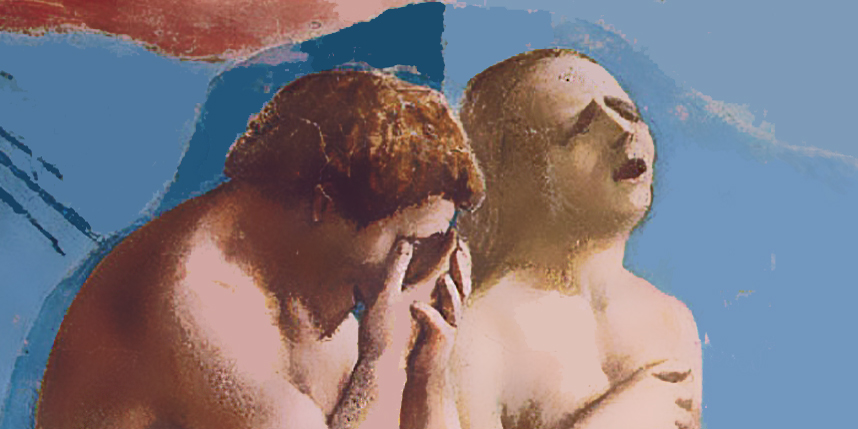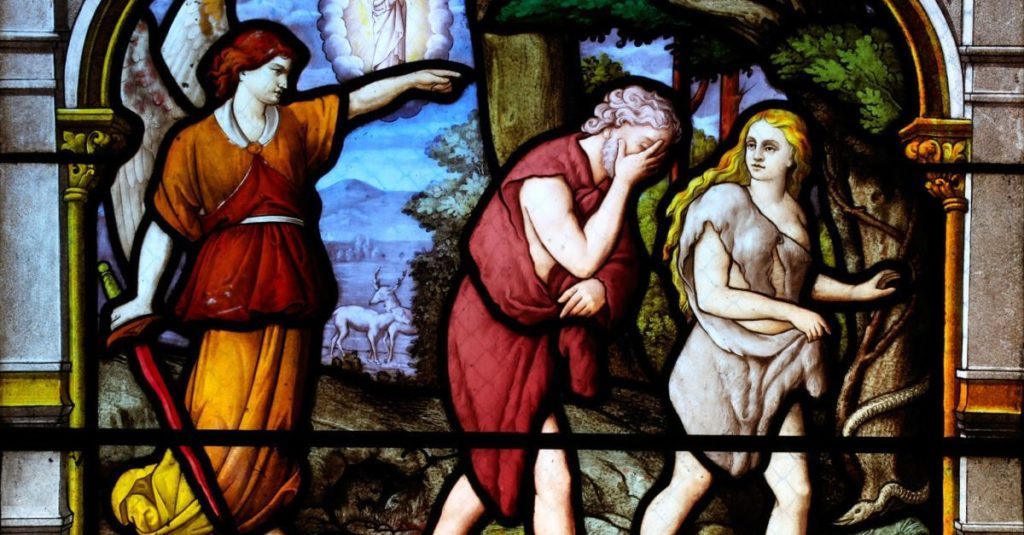
The following is an excerpt from Will McDavid’s truly brilliant book, Eden and Afterward: A Mockingbird Guide to Genesis. McDavid provides an exceptional reading of the Genesis narrative with deeply personal and pastoral insight. To purchase the book (for just $10), click here.
What we can understand, pretty naturally, is the Fall’s effects, because they are the air we breathe; they characterize us. And the immediate result is the beginning of physical modesty — the two cover up with fig leaves. The image here is reminiscent of a five-year-old who gets caught misbehaving and immediately covers her eyes with her hands. Our pasts cannot be hidden, but we can hide our physical selves. Covering-up is the natural response to shame, guilt, and knowledge of wrongdoing.
And then there’s the idea of separation. Physical modesty always arises out of some distance from the people around us — the primal discomfort of being naked around others happens mainly because it feels too close, encroaching. There is a basic separation between Adam and Eve, Adam and God, and Eve and God that serves as a prerequisite for this modesty.
To keep following the thread, what about the thought of being naked in Times Square on a Tuesday afternoon makes us uncomfortable? The exposure, maybe — but why would exposure make us uncomfortable? It’s those feelings that form a natural bridge into the world of the story. Why does anyone ever need to hide?
It’s a complicated question with a number of potential answers, but one we could suggest for this story would be uncertainty about whether or not we will be accepted. Again, our bridge into stories is always empathy with the characters, seeing ourselves in them, so we have to think back to that last big screw-up — major — that you have had to cover up, hide. Think for a second. What would your wife (or boss/preacher/kid/brother) say if they knew that about you? What would they think?
Feeling our way through this sense of shame and consequent desire to hide it, we see a fundamental tension begin to emerge, one that will be the psychological locus of many of the biblical stories: there is a tension between the desire to be loved and the desire to be self-sufficient. If we told our wife/boss/father about that bad decision we made, we fear they might reject us. So we cover up to present our best selves to others. That can inhibit us from being loved, because being loved requires being known. Those of us who like to present to others our illusions of having it all together cringe at the thought of being loved not through strength, but through forgiveness. That is, even if we know things will work themselves out in the end and that someone who sees the worst in us will love us anyway, even then — that doesn’t help the fear of coming clean very much. Because the experience of shame will still be there, perhaps even more if we’re going to be loved in a new way, a way in which we know at every minute that we do not deserve it.
Of course, this kind of undeserved love can be wonderful, once we get used to it. But at first, we’d so much rather be self-sufficient — that is, have ground of our own to stand on — than be loved in the midst of our shame.
So being truly loved and being self-sufficient are in conflict. Being loved, at its height, means being loved within our weaknesses and failures; being loved in a way that is simultaneous with being known. But being self-sufficient means pretending those weaknesses do not exist; it entails performing and earning.

Modesty comes as the first sign of what will be fallen man’s solution to the problem of being loved and being self-sufficient. Hiding, pretentiousness, putting on airs — these are how we now try to earn love. Not surprisingly, they all involve concealing our weaknesses. Perhaps I am reading into the story a bit here, but Genesis itself will interpret the symbol of the fig leaves in a similar way, an interpretation carried out in later stories as well.
You have sinned, therefore you must hide that sin. You cover up your professional incompetence or looming bankruptcy or your heavy drinking, your son’s depression or the fact that you’re in therapy, or the creeping suspicion that your marriage is becoming loveless. Weaknesses like these are not things we like to advertise — usually, they’re things we hide from our spouses, parents, children, and sometimes, even from ourselves.
Of course, clothes have a protective function, too — some element of concealment is necessary and can even be good, all things considered. The shame of being fully known is not something that we can bear; even though we are “fully known” (1 Cor 13:12), the art of being vulnerable and defenseless before God is a task for a lifetime. The fact that we’re not forced to deal with our shame — indeed, we may not even be aware of our faults — can be a gracious one. Just as Adam fell by denying his limited, creaturely status, some element of human redemption involved re-dis–covering ourselves as sinners. The theme of clothes as covering who we really are will be reprised throughout the entire Bible, from Joseph’s “Technicolor dreamcoat” to Paul’s exhortation to “put on the Lord Jesus Christ” (Rom 13:14). The symbol’s biblical root is here in Genesis, in the idea of vanity covering over shame.
The clothing also represents our need to hide our shame from each other, the first “horizontal,” or person-to-person, effect of the Fall. Paralleling this is the symbol of “vertical” shame, the need to hide from God. In this, Adam and Eve literally hide behind a tree; again, the best analogy here is probably a child running away after doing something bad, and this biblical passage is the archetype for that sort of shame. The unity between the “horizontal” fig leaves and the “vertical” hiding asserts the strongest connection between the brokenness in our relationship with God and the dysfunction in our relationships with others. People are united in their vulnerability and exposure before God; self-sufficiency is innately individualistic and isolating from others. Here again we see the strangely circular character of the Fall: the need for self-sufficiency drives Adam and Eve to eat the fruit, and eating the fruit separates them from each other and from God, thus forcing them to actually be self-sufficient.

Another apparent result of the Fall has to do with blame-shifting. Given Adam and Eve’s participation in what has happened, they know that there is guilt; they have become guilty. Try as we might, there is no way to deny the universal reality of guilt; each of us feels it in our shame before the other, and before God. But even though guilt itself cannot be denied, there is a way to deny that guilt applies to me, and that way is to localize the reality of guilt in someone else. More commonly, we call this blame-shifting, and like shame, it can be observed from early childhood on. I tell my parents that the DUI was someone else’s fault; I rationalize my son’s flunking a course by telling all my friends how Mrs. Johnson always had it out for him; I blame my recent unemployment on my boss’s blindness to my ability.
Regardless of whether or not the Fall in Genesis actually happened historically (I personally think it did), its marvelous literary composition testifies to its value. Is anyone exempt from hiding and blame-shifting? And who can deny that hiding our true selves and blaming others for our own shortcomings are at the very root of human dysfunction? The story accomplishes all of these insights — and infinite, ineffable others.
Each of us wants to exempt ourselves from the sin of the human race, just like Adam did (“Eve gave me the fruit!”) and Eve did (“the devil made me do it!”). By shifting blame, we seek to place ourselves in the “good” camp and others in the “bad.” This self-righteous attempt to exonerate ourselves not only fractures friendships and families, but also it’s one reason why the church, frequently accused of self-righteousness, has lost credibility in the contemporary world. Some might say this need to form sharp us-them divides plays a major role in nations that have turned violent or totalitarian. One such example of national self-righteousness came with the immensely puritanical Soviet regime, which gradually developed an ideology to make itself the embodiment of all human goodness and progress — which served as a justification for terrible crimes and suffering. A prominent prisoner of that regime, during its most brutal phase under Stalin, rightly saw through the war crimes and horrors to the moral self-justification underneath:
If only it were all so simple! If only there were evil people somewhere insidiously committing evil deeds, and it were necessary only to separate them from the rest of us and destroy them. But the line dividing good and evil cuts through the heart of every human being. And who is willing to destroy a piece of his own heart?
In terms of our lives — “practical application” — the story of the Fall is above all else a call to recognize, through our affinity with Adam’s self-sufficiency, covering-up, and blame-shifting, our own bias toward denying our dependency and guilt. Recognizing (re-cognizing) our Adamic denial of our own sinfulness, shame, and guilt is the empathetic touchstone of the story, as well as a vital step toward a genuinely religious life. We will always struggle to deny it — such struggle is so deeply-rooted that it cannot ever be fully extirpated — yet such a denial only proves, by the logic of Genesis 3, that we are in fact sinners, as it proved that Adam and Eve were. The line runs through our own hearts, too, and recognizing our participation in Adam’s sin can ultimately open us to grace, especially for those who believe that God comes specifically for “the sick” (Mk 2:17).
*****
One last thought: God curses Eve with pain in childbirth and Adam with futility in work. According to the story, these were the original two callings of humanity — to fill the earth and to subdue it. Now neither will be possible without pain and heavy toil. We will not be able to fulfill our function as human beings perfectly, and our trouble with fulfilling both of these Genesis callings will serve as enacted, lived symbols of weakness and futility: on the negative side, pain and toil, but on the positive side, reminders of the truth that we are not self-sufficient.
Our original theological question was, “Who’s to blame? God, for making Adam and Eve capable of sin, or the serpent, for forcing them into it?” Now, through the story’s literary sense, this question can finally be properly addressed: The Fall is a reality, we are definitively guilty, and questions about who’s to blame only prove that we are truly sinful — and truly responsible. A dark conclusion, to be sure, but no darker than we should expect from a story about how evil, pain, estrangement, shame, pride, and betrayal entered the world. Which isn’t to say that original sin is, at least not first and foremost, a theological truth to which we give assent. No, it is one to be inevitably, tragically lived out — and for that we turn to Cain and Abel.

COMMENTS
One response to “The Conflict Between Love and Self-sufficiency: Life After “the Fall””
Leave a Reply













A classic! One of the first books I read from mockingbird & it made me want to stick around